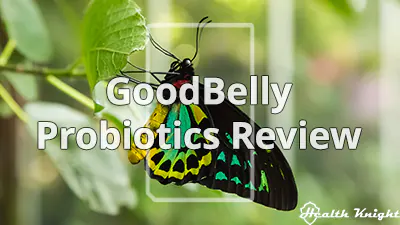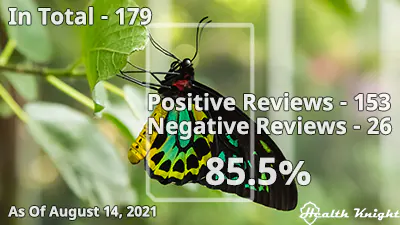| Marketing | Ingredients | Side Effects | Reviews | Pricing | Pros & Cons | Overall |
According to the GoodBelly Probiotics reviews posted by customers, it can’t be said enough how good this product is. Many people absolutely swear by it since this has managed to fix their digestive issues, even often when nothing else helped. Others adore the fact that the capsules are easy to swallow and tasteless. Some mentioned that this has even helped in times of food poisoning.
So, in this GoodBelly Probiotics review, we will be taking a supremely close look at the Probiotic supplement created by the Good Belly brand.
Hence, the idea is to be no extension of the manufacturer’s marketing or other similar nonsense. This is all going to be about what I feel is the truth, the whole truth, and nothing but the truth. And we’ll do that in assessing for marketing, ingredients, side effects (additives), customer feedback, and pricing. We’ll do it the truth-seeking way.
Marketing | There Is No Marketing With GoodBelly Whatsoever
According to the manufacturer, the GoodBelly Probiotics is “packed with 10 billion live & active cultures of superhero probiotic LP299v.” Per their words, the “unique strain is recognized as one of the most effective probiotics available.” Meaning, “its efficacy is backed up by more than two decades of research with 60 human clinical trials.” And that’s, indeed, a lot of research [R].
 As far as the product page goes, it’s one of the simplest and straightforward ones I have ever come across. And I’ve come across many.
As far as the product page goes, it’s one of the simplest and straightforward ones I have ever come across. And I’ve come across many.
One of the reasons for that is likely the fact that we can’t really purchase the supplement from their website. It doesn’t offer that kind of functionality. Instead, if we want to buy it, we’re forwarded to Amazon.
And so, through that, the product page of the GoodBelly Probiotics just inherently doesn’t contain any marketing. Hence, no coaxing to buy many right off the bat like with the 1MD Complete Probiotics Platinum (review). Also, no money-back guarantee like with the Dr. Mercola Probiotics (review). And definitely no unnaturally positive customer reviews like with the BioTrust PRO-X10 Probiotic (review).
To add to that, they don’t really elaborate on the potential benefits too much either. They do imply digestive and gut health improvements through the notion of keeping our bellies happy. But other than that, there isn’t anything else.
Whereas for the allergen information (free-of claims), GoodBelly Probiotics is Vegan, Dairy-Free, Sugar-Free, and Gluten-Free. The Good Belly product is also stated to be free of Artificial Colors and Flavors. But is the supplement really worth our while?
Ingredients | As Far As Ingredients, Potency Is OK, Variety Is NOT
I definitely don’t have a positive outlook on that as far as the beneficial ingredients go. I mean, it offers fewer strains than the One A Day TruBiotics Probiotic (review). At least it comes in decent total CFU amounts per capsule just like the Gives Health Wholesome Probiotics (review). Still, there are other things not optimal about it.
So, per serving (one capsule), the supplement of this review offers 10 Billion CFU of a patented Lactobacillus plantarum 299v. And that’s all there is to the GoodBelly Probiotics. It doesn’t add anything else.
 So, what does that mean?
So, what does that mean?
Well, for starters, it means that we only get one strain of Probiotics. Which is not optimal, to say the least. I mean, ideally, we should be striving for at least 10 different ones, the way I see it [R, R, R, R].
Whereas, on the other hand, it is the Lactobacillus plantarum 299v (or LP299V). I’m not sure whether it’s the most studied Probiotic strain but it definitely has a ton of research behind it. Hence, it’s certainly a good one, and it has been proven to help fight diarrhea, reduce cholesterol levels, improve skin health, battle ulcerative colitis, candidiasis, IBS, obesity, and high blood sugar levels, enhance immunity, ward of allergies, as well as help digestive health just in general [R, R, R, R, R].
Also, it comes in amounts recommended by the best practices for nutrient amounts. Thus, plenty of juice to make all of the potential benefits happen. Still, to adhere to that fully, we would need two capsules of the GoodBelly Probiotics daily. Which is also something that they suggest (1-2 capsules daily is what they recommend). That said, it would mean that one container is only good for 15 servings or half a month’s worth. And that will take a toll on the total cost [R, R, R, R, R, R, R, R, R, R, R, R, R, R, R, R, R].
Another thing I don’t like is that it forgets stuff like Prebiotics. The way I see it, every decent, self-respecting Probiotic should have those. The GoodBelly forgoes them. Which just means that there’s less of the good stuff for the belly [R, R, R, R, R, R, R, R, R, R, R, R].
Another thing I do keep an eye out for is third-party testing to really approve the quality of a Probiotic. The supplement of this review not only doesn’t have that, but the words on quality also don’t really convince. I mean, they’re doing some testing to approve the Probiotic count. But what about purity? I think that’s still important given the manufacturing processes. Plus, they don’t claim to be Non-GMO. Which means that it probably is. And that’s not ideal.
Side Effects | Additives In This GoodBelly May Be Highly Misunderstood
Side effects are the product of additives. And additives can really kill one’s mojo for any supplement. To that end, to some extent, the beneficial ingredients and substances are kind of the easy part. They’re typically the aspect that doesn’t do side effects or has very little potential for that. Whereas additives are the opposite. And so, it matters what kind we choose.
For example, something like both the Align Probiotic (review) and the TruNature Advanced Digestive Probiotic (review) uses a substance known as Titanium Dioxide. And the natural form of that is fine. But it’s likely that these supplements use the nanoparticle form which can cause lung, kidney, liver, brain damage, and more [R, R, R, R, R, R, R, R].
 And there are plenty of other potentially very harmful additives out there. So, what about the Probiotics of GoodBelly in this regard?
And there are plenty of other potentially very harmful additives out there. So, what about the Probiotics of GoodBelly in this regard?
It uses just three of them. Potato Starch, Hydroxypropylmethyl Cellulose, and Vegetable Magnesium Stearate. But almost any blogger or even doctor will try to convince you that this is not a winning combination. All because of Magnesium Stearate.
You see, it is basically a substance most misunderstood on the internet. It’s crazy to me how superficial understanding of the available research can breed misinformation. I mean, I don’t pretend to know every aspect or study there is but I spent some decent two-digit number of hours on this alone [R, R, R, R, R].
And I have to conclude what the minority of doctors agree on. Meaning, that Magnesium Stearate is arguably one of the most harmless additives there is, period. All that raving about it giving cancer is exactly that. It’s just irrational and incoherent talk that has no real basis. Moreover, it’s inverse to our biology [R, R, R, R, R].
But to further add to that, consider this. The ingredient responsible for giving cancer (supposedly) is Stearic Acid (a constituent of Magnesium Stearate). But babies consume tons of it with mother’s milk. Do they all have cancer? No. Not even close [R, R, R, R, R].
As for the Potato Starch and Hydroxypropylmethyl Cellulose, those are fine to do. I would not hesitate a supplement because it has either one of them.
Reviews | For Customer Reviews, We Don’t Have Many But Seems Fine
While many supplement manufacturers these days do offer a customer review section for us to learn more about their product, GoodBelly Probiotics is not really that kind of thing. As we discussed earlier, they are very brief with the information they do offer. And hence, kind of inherently, we have to look at the other sites for customer input.
 Unlucky for us, there is not plenty of them out there. Other than Amazon, there was only one other site that I found that offered customer reviews on this GoodBelly Probiotic.
Unlucky for us, there is not plenty of them out there. Other than Amazon, there was only one other site that I found that offered customer reviews on this GoodBelly Probiotic.
So, in total, I managed to find just 179 pieces of customer feedback. Of these, a total of 153 were positive (three-star, four-star, five-star) and 26 were negative (one-star, two-star). Hence, per the GoodBelly Probiotics reviews, the global success rate is just marginally over 85%. Or to be exact, 85.5%. And that’s not a high percentage.
I mean, it’s still a fine one given that basically every 85 people out of 100 were happy with the thing. But I’ve found that quality Probiotics typically beat the 90% threshold. And the supplement of this review does fall short of that.
So, a bit higher number of unhappy people than usual. But what were they unhappy about?
Different things. For some, the GoodBelly caused BadBelly. Meaning, nausea, stomach pain, cramping, and horrible gas. Some even encountered heartburn. For others more, it made absolutely no difference at all. Whereas for some others, it was the notion of getting opened bottles that they did not risk using. And I wouldn’t either.
I mean, there are certainly enough people that also do swear by these Probiotics. But they certainly don’t work for everyone.
Pricing | To Review Pricing, I Believe This Is Some Of The Worst
For the purposes of this GoodBelly Probiotics review, another thing to take a look at is pricing. Because even supposedly decent supplements do get overpriced all the time. I mean, for sure, there are also reasonable options. But I feel, to an extent, we can easily fall for the overpriced ones. And their marketing is definitely a huge factor when it comes to that. Because there are many ways to mask the high price.
 So, per container (30 capsules), the GoodBelly Probiotics supplement costs $19.99. Thus, that’s 66.6 cents per capsule. That’s $1.33 if we’re doing two capsules, as I suggested earlier. Either way, in terms of easily comparable value, the supplement of this review costs 66.6 cents per every 10 Billion CFU.
So, per container (30 capsules), the GoodBelly Probiotics supplement costs $19.99. Thus, that’s 66.6 cents per capsule. That’s $1.33 if we’re doing two capsules, as I suggested earlier. Either way, in terms of easily comparable value, the supplement of this review costs 66.6 cents per every 10 Billion CFU.
Which despite what people sometimes say in their own GoodBelly Probiotics reviews is not that cheap.
I mean, compare it to something like the Smidge Sensitive (GutPro) Probiotic (review). It’s not a supplement I would shortlist but still, it offers plenty more strains, decent additives, and it costs exactly half what this GoodBelly costs (namely, 33.3 cents per every 10 Billion CFU).
Other than that, sure, there are also supplements that are more expensive than the one of this review. One such example is the Natren Healthy Trinity (review).
Now, Natren typically costs $69.95 for a package of 30 capsules, 30 Billion CFU each. To do the math, that’s 77.7 cents per every 10 Billion CFU. So, it’s more costly than GoodBelly, but it also offers third-party testing, Non-GMO, more strains, and great additives, too. It’s just better and considerably more value for the money.
But here’s another one. The Live Conscious Pro-45 (review). I mean, it’s got all of what Natren has got over the GoodBelly. But it’s way more affordable. It’s about a third of the price.
So, it does kind of make one really doubt the GoodBelly Probiotics. I mean, yes, it’s cheaper than some other brands out there but, generally speaking, it is not a high-value option for the price at all. The danger, however, is that there are customer reviews which claim that it’s cheap, and because of them people actually start to believe that. But don’t get played like that.
Pros & Cons | Generally Speaking, It’s Both Good & Bad
| Pros | Cons |
|---|---|
| ✓ The GoodBelly Probiotics offer good amounts of total Probiotics (two capsules). | ✘ The Good Belly product offers just one Probiotic strain. |
| ✓ The supplement uses decent additives. | ✘ The supplement doesn’t offer any Prebiotics. |
| ✓ The success rates are fine but they could be better. | ✘ The Probiotics of this review likely contain some GMO ingredients. |
| ✘ The product does not do third-party testing. | |
| ✘ It comes at a rather high price. |
Overall | I Would No More Than Consider This Probiotics Supplement
To be honest, I don’t like the GoodBelly attempt at Probiotics at all. I mean, what is this? Yes, it’s a nice-looking container. Yes, it’s got a very pleasant product page. But the product itself is pretty low.
Yes, for positives, it offers plenty of CFU and decent additives. And I like that. But it also provides only one strain, no Prebiotics, no third-party testing or, as far as I can tell, real quality in terms of purity. Furthermore, it probably uses GMO ingredients since there is no Non-GMO claim made for the supplement.
 Yes, it could be argued that the success rates are fine. But the price is not. And there is no way around that. And so, it’s far from ideal.
Yes, it could be argued that the success rates are fine. But the price is not. And there is no way around that. And so, it’s far from ideal.
But (out of avoid it, consider it, shortlist it, buy it) I would still reckon we should consider it. It’s got plenty of potency and the right idea of things, generally.
To this end, I have to note that I’m not a fan and I would never buy it. But maybe there are people for who it makes sense. I would go with the previously mentioned Live Conscious Pro-45 (full review). It’s just the better, more potent, more quality supplement.
Above all, I hope this GoodBelly Probiotic review helped you find the information you were looking for. If you have any thoughts or questions, I’m all here for you. And do feel free to leave your own personal reviews on the product as well.
I admit this is something I have very limited knowledge of, but this article was very informative. Wow! There is one thing though, what is the difference between a probiotic and a prebiotic? I’m more of a tech person than biology, so it is a little confusing to me.
It doesn’t always ring true that you get what you pay for, but some people are content with just enough. I always go with a supplement that has the highest potency and the widest range of nutrients so I feel like I’m getting the most out of it, but I wonder if that makes any real difference.
Hey, T-Rx!
Probiotics are the live microorganisms that have the capacity to positively impact our health. Whereas Prebiotics are non-digestible food fibers that promote the growth of these live pro-life organisms.
Personally, I think that it makes a profound difference, especially when it comes to Probiotics. Because our microbiome (the natural bacteria composition present in our gut) homes a ton of different beneficial organisms, and so, it makes sense to have a bunch of different ones in the product. Still, in some cases, I think specializing and offering just one specific strain can work wonders as well.
It all kind of depends on what our particular needs are. Going with a more thorough diversity is what I believe is best for general health and well-being.
Cheers,
Matiss
If the probiotic does not have the third party review does that, in your experience, discredit the product from being genuine?
What does magnesium Stearate do to the body if it is not cancerous?
It does still seem steep in price. But is the product effective to your knowledge? Without a non bias review on the product I would not believe all the hype myself.
Hey, Alex!
Thank you for the questions. I love your inquisitiveness.
So, as for third-party testing, no, this is not about proving that the product is genuine or not. Meaning, it is not about evaluating whether or not it’s a fake. It is all about assessing what kind of purity (thus, safety) and potency does it have when compared to the label.
Thus, the first aspect (purity) deals with whether or not the product holds any toxins, heavy metals, and other potentially harmful aspects that may be both due to ingredients or manufacturing processes. The other aspect deals with whether or not what is listed on the label is actually there. Because there have even been cases with Turmeric supplements where a brand claims that there’s a certain amount of Turmeric there. But when a third-party test is done, it turns out that there is not only less than what is claimed on the label but there is none.
Which is mind-boggling. But stuff like that does happen. Hence, third-party testing is necessary, especially when we’re talking brands that do not make it very obvious what kind of manufacturing quality they adhere to.
As far as Magnesium Stearate goes, all substances we consume are not either harmful or helpful. Meaning, if it doesn’t harm us then it must be helpful. No, there’s also the in-between. Namely, they can be harmless. To that end, Magnesium Stearate does nothing. We have inherent biochemical processes to avoid what causes its toxicity in rodents (rodents don’t have such biochemical processes).
With the amount of Probiotics that it provides, I’m sure that it can be helpful. And if you’re someone who’s specifically after Lactobacillus plantarum only, then it’s definitely an option. That said, I believe there are better ways to do it. Plus, many Probiotic supplements do have Lactobacillus plantarum as part of their Probiotic strain profile.
Cheers,
Matiss
When it comes to probiotics, I’m very particular. I never heard of GoodBelly until now. Your review has given me enough insight to regard this product with utmost caution. I do this anyway with everything, but I find GoodBelly is a bit pricey for a supplement, but I could simply be acting like a scrooge at this point as I am very fussy!
Hey, Millie!
I absolutely get that. And, yes, indeed, it is quite a pricey one.
I don’t think that’s acting like a scrooge. That’s kind of the unforgiving truth. :)
Cheers,
Matiss
Hello, I must say that upon first viewing this article, the font does seem a bit small. I appreciate the research you did to disprove the myth that Magnesium Stearate is harmful. It certainly looks like you did your research and inspected all of the ingredients. It’s also good that you compared this product to other similar products especially as far as price is concerned.
Hey, Andrew!
Hmm, I will have to look into that. I appreciate the feedback.
Yeah, the aspect of comparing things a lot is a relatively new concept for the articles. Happy to hear it works out and fits in well.
Cheers,
Matiss
I love how you mention it has a nice container. Like, I know there are way more important things to be concentrating on here but if I was going out to pick a probiotic I would be drawn to the nicer container as I am a very visual person. That means the visual aspect is actually very important and it isn’t just about the ingredients listed on the bottle. That said, I would never have known to put potency over variety.
Hey, Kelly!
Yeah, I absolutely feel you. I think it makes so much sense. It’s something that I actually take into account when evaluating supplements very rarely but I do know what you mean.
The better-looking peers will, indeed, sell better. I mean, just the idea of an awkward-looking supplement will, for sure, sell worse. Hence, it must be true that the great-looking one sells better. It’s probably something I have to take into consideration more often when evaluating the marketing aspects. I appreciate the thought.
Cheers,
Matiss